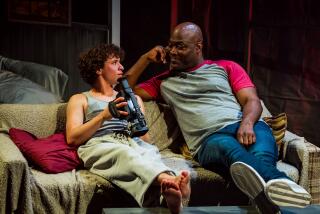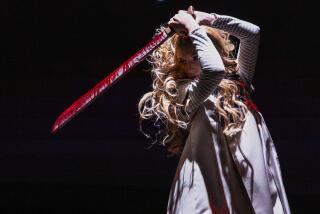âNemesisâ leaves little to imagination
Contemporary without being genuinely new, splashy without being particularly original, the abstract dance drama âNemesisâ seemed most of all an index to familiar modernist preoccupations in its U.S. premiere Friday on the UCLA Live series in Royce Hall.
British choreographer Wayne McGregor displayed a talent for liquid body sculpture and off-balance virtuosity -- qualities evident in his own dancing in a star solo near the end of the hourlong piece as well as in the stamina-testing performances of the 10 other members of his Random Dance company.
However, he blunted interest in his movement style in the first half of the piece by an emphasis on dead-end discontinuity on a dark stage to overamplified music: standard procedure in millennial movement theater, especially imports. As usual, random dancing yielded random perception; if you tuned out, you missed nothing essential.
The music composed by Robin Rimbaud, a.k.a. Scanner(performed live), initially piled up throbbing riffs mixed with voices and sometimes orchestral underscoring -- a kind of cultural synthesis that became an overwhelming wall of sound before shifting to simpler percussive rhythms in the pieceâs last half.
Major changes also turned up in Ravi Deepresâ video projections and Lucy Carterâs lighting design, with small colorless views of uninhabited rooms eventually going up in flames, leading to a few minutes of moving images that filled the whole, stagewide projection screen.
Most of the time, however, the audience watched dancers isolated against a blank (or mostly blank) back wall -- low-interest high-tech some 50 years after Alwin Nikolais and others made projections a mobile, unpre- dictable component in dance design.
If you interpreted âNemesisâ as a quasi-narrative, you could see the chaotic, pointless encounters of Part 1 as a portrait of a rootless human society doomed to perish in all those projected flames.
After apocalypse, McGregor introduced a whole new creepy-crawly-critter look -- but the novelty proved undeveloped and unsatisfying.
In Part 1, his dancers wore fashionable loose tops over shorts credited to Stonewood and Bryce. In Part 2, they represented a grim, humanless future in gleaming black insectile body-suits ornamented with long prosthetic arm extensions, hinged in the middle, that they could flip open and closed like jackknives.
Created by Jim Hensonâs Creature Shop, these pointy arms inspired generalized bug swarms and inconclusive battle sequences, but neither an introductory solo by Hilary Stainsby nor a climactic duet by Odette Hughes and Antoine Vereecken provided anything but obvious uses for them.
Given a choice between exploiting such techno toys and pursuing sustained dance expression, McGregor always chose the former but then kept the result from achieving any imaginative breadth by settling for preliminary and often old-fashioned effects.
Because he wanted swirls of light and buzzing wings soaring over him, he put his solo behind a gauze curtain -- always a sure way to deaden the kinetic impact of dancing. Couldnât Deepres or Carter or designer Sharon Smith have helped him dispense with tons of see-through yardage in this brief but crucial final passage so that the performance would remain unsmothered? Apparently not.
If the difference between a gimmick and a metaphor lies in the degree of creative exploration, âNemesisâ stayed mundane because it used technology as a crutch and never became ambitious enough about getting its concept of transformation into the dancersâ bodies. Yes, McGregor sent signals of his intent via the score, projections and costumes, but he always seemed reluctant to shape or color the movement.
A pity, since the company exuded power and versatility. Laila Diallo and Leo Lerus looked especially impressive in an intense duet early in the piece, and Ngoc Anh Nguyen introduced a new facet of his phenomenal expertise with every entrance. It would be great to see these dancers in a more purely choreographic vehicle; on Friday, they were way out of place in McGregorâs roach motel.
Besides the dancers mentioned, the company included Claire Cunningham, Khamlane Halsackda, Matthias Sperling and Amanda Weaver.
More to Read
The biggest entertainment stories
Get our big stories about Hollywood, film, television, music, arts, culture and more right in your inbox as soon as they publish.
You may occasionally receive promotional content from the Los Angeles Times.










